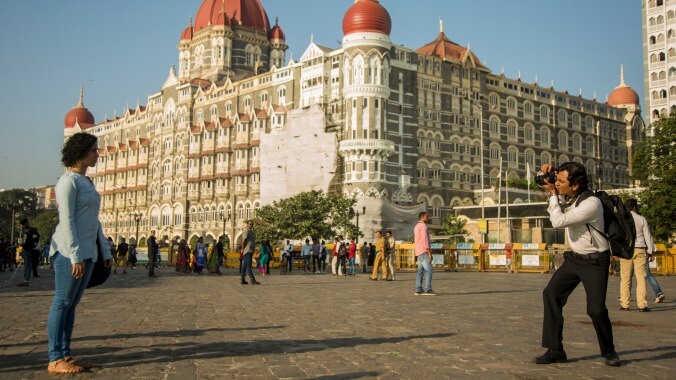Photograph takes a quiet, affecting snapshot of a clichéd rom-com premise

The photographer at the Gateway Of India in Mumbai makes an unusually poetic sales pitch. Rafi (Nawazuddin Siddiqui), trying to sell Miloni (Sanya Malhotra) on a touristy souvenir photo, promises not only the instant capturing of a memory, but also the potential to recall exactly what she was doing at that moment—though he makes clear that this is no guarantee. All this for just 50 rupees. Make that just 30! Although there’s nothing particularly special about that moment in Miloni’s life—she’s not a tourist, for one thing—she accepts the deal. He snaps and prints a photo, and when he’s momentarily distracted, she runs off without paying, taking her new snapshot with her.
Photograph continues to follow both characters as they separate, the expectation hanging in the air that they will somehow reunite. Miloni is younger that Rafi—or maybe just looks that way, because she has some degree of privilege, living with her middle-class family and taking accounting classes, while Rafi shares a flat with multiple friends who must sleep mere feet from each other. They’re both weighed down by the expectations of their families; her parents are adamant that she must focus on her studies and get a respectable accounting job, while his grandmother sends messages from their village about her everlasting hope that he will marry as soon as possible. There’s a slightly surreal running gag about how despite the bustle of the Mumbai streets, Rafi somehow constantly runs into people passing along his grandmother’s complaints.
To calm her fears (and get her off his back), he prints out another copy of Miloni’s photo and encloses it in a letter home, passing her off as his new girlfriend. When his grandmother Dadi (Farrukh Jaffar) comes for an extended visit, Rafi tracks down Miloni and convinces her to go along with the ruse. Writer-director Ritesh Batra (Our Souls At Night, The Lunchbox) doesn’t actually show their confrontation, or Rafi’s proposal, which turns out to be a remarkably effective strategy. He trusts that the audience understands what Rafi wants, and might at least have some idea of why Miloni is willing to go along with this scheme. In doing so, he spares viewers one of those trailer-friendly scenes where characters in the movie essentially pitch a concept to each other.
An American telling of Photograph would almost certainly involve some degree of zaniness. In fact, the film features such a down-the-middle rom-com setup that its melancholy, awkward treatment of the premise provides the kind of brisk refreshment that rom-coms are supposed to, even though Batra subdues both the romance and the comedy (such as it is) to the lowest possible simmer. Rafi and Miloni spend time together, first on outings with Dadi and then, occasionally, without her. Neither ever really raises their voice, and even the hectoring Dadi is relatively genteel. Batra repeatedly pushes in slowly on Malhotra during scenes where she has few lines (which, to be fair, describes most of her scenes), scanning her face for signs of the quiet desperation that seems to be forming below a placid surface.
With such subtle performances in the foreground, Batra’s filmmaking sometimes appears to call attention to itself, even when it’s not especially ostentatious. The first half of the film indulges in some eye-catching but sometimes bizarre back-and-forth cuts that blur the line between simple shot/reverse-shot conversations and purposeful violation of the 180-degree rule. But whatever disorienting effect may be intended, it doesn’t always appear worth the effort. The second half pivots to some complicated mirror shots that better communicate the ways these characters connect (and don’t connect) with each other.
What’s consistent about Photograph is the way it maintains the delicacy of a particularly fine short story, complete with some ghostly supporting characters and plenty of ellipses where more conventional movies would amp up the exclamation points. The final scene in particular pointedly avoids closure, even more than its early moments avoid unnecessary exposition. It’s possible that several other scenes in the 15 minutes or so that precede it might have made for similarly elliptical but slightly more satisfying endings. It’s also possible that the film’s final moment will linger, and be recalled with great clarity. Batra admits up front that it can be difficult to know for sure.